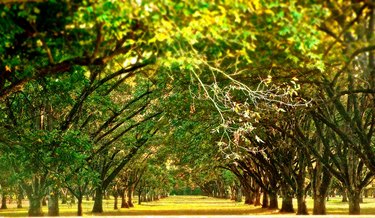
A healthy pecan tree (Carya illinoinensis) growing in fertile soil produces a lush, full canopy of dark green leaves in spring and early summer. Pecans grow in U.S. Department of Agriculture plant hardiness zones 5 through 9. Most trees require at least one annual fertilizer application to remain healthy through summer. Fertilize pecan trees properly to encourage better growth and production of a better nut harvest each year.
Guidelines for Fertilizing Pecan Trees
Video of the Day
How much fertilizer you need to use depends on the quality of the soil and the age of the tree. Soil testing provides the best guide when determining product quantities when you fertilize pecan trees, especially for those growing in lawns that get fertilized. While it's best to have your soil tested by a lab or extension service, you can get a rough idea with a home testing kit, which you can buy at garden centers.
Video of the Day
For optimum pecan tree health, soil testing is definitely desirable. Testing determines which essential elements and in what quantities currently exist in the soil, and which are deficient or totally missing. If you decide to skip testing, a general application of a complete fertilizer, such as a 10-10-10 blend, using 4 pounds per 1 inch of trunk diameter should work without creating problems.
Best Time to Fertilize Pecan Trees
These plants benefit from fertilizer twice a year. Fertilize pecan trees at the end of winter dormancy, in late February or early March. If the tree grows in a fertilized lawn, this is usually the only general-purpose fertilizer application needed. Trees growing elsewhere benefit from a nitrogen fertilizer application in late spring, usually May or June. It's best to refer to soil test results before you fertilize with nitrogen. If you apply this second treatment without testing, apply 1/2 pound of ammonium nitrate for every 1/2 inch of trunk diameter.
Fertilizer Application Method
The root zone of a pecan tree extends up to two times as wide as the spread of the canopy of branches above. When applying fertilizer, broadcast it over the entire estimated root zone, beginning 1 foot out from the base of the trunk. Spreading the fertilizer evenly with a hand or push spreader helps prevent clumping and fertilizer damage to lawn grasses. During dry weather, water the area well with 1 to 2 inches of water after you spread the fertilizer.
Addressing Zinc Deficiency
Pecans suffering from a lack of zinc produce poorly and may develop bronze, mottled leaves, leaf and twig dieback, and tip rosettes of yellow leaves. Use a 19-10-5 fertilizer with 2 percent additional zinc, often sold specifically as a pecan fertilizer, to prevent these issues. Alternatively, apply 1/2 pound of a 36 percent zinc sulfate fertilizer for every 1/2 inch of trunk diameter every three years during the dormant fertilizer application. Applying to the soil works better on neutral or acidic soil. In soil with a pH above 7.0, dissolve 3 tablespoons of the zinc sulfate in 1 gallon of water. Spray the pecan tree's leaves with the solution at 14-day intervals, beginning in April. Mature trees need three applications, while young trees require five applications.